2015 VOLKSWAGEN POLO airbag
[x] Cancel search: airbagPage 70 of 100

Downloaded from www.Manualslib.com manuals search engine 12/29/2015Bedienungsanleitung < Service & Zubehör < Volkswagen Deutschland
35/136
Whenever the vehicle is in motion:
Never stand in the vehicle.
Never stand on the seats.
Never kneel on the seats.
Never tilt the backrest too far to the rear.
Never lean against the dash panel.
Never lie on the rear bench seat.
Never sit on the front edge of a seat.
Never sit sideways.
Never lean out of a window.
Never put your feet out of a window.
Never put your feet on the dash panel.
Never place your feet on the seat cushion or seat backrest.
Never travel in a footwell.
Never sit on the front armrest.
Never travel on a seat without wearing the seat belt.
Never travel in the luggage compartment.
Correct sitting position
Fig. 39 There must be a distance of at least 25 cm between the driver and the steering wheel
Every incorrect sitting position in the vehicle increases the risk of severe or fatal injuries in the event of an accident or sudden driving or braking
manoeuvre.
All vehicle occupants must maintain a correct sitting position and wear their seat belt properly while the vehicle is in motion.
Sitting in an incorrect position, not fastening the seat belt, or being too close to the airbag exposes the occupants to the risk of sustaining
critical or fatal injuries, especially if the airbags are triggered and strike an occupant who has assumed an incorrect sitting position.
WARNING
Page 71 of 100
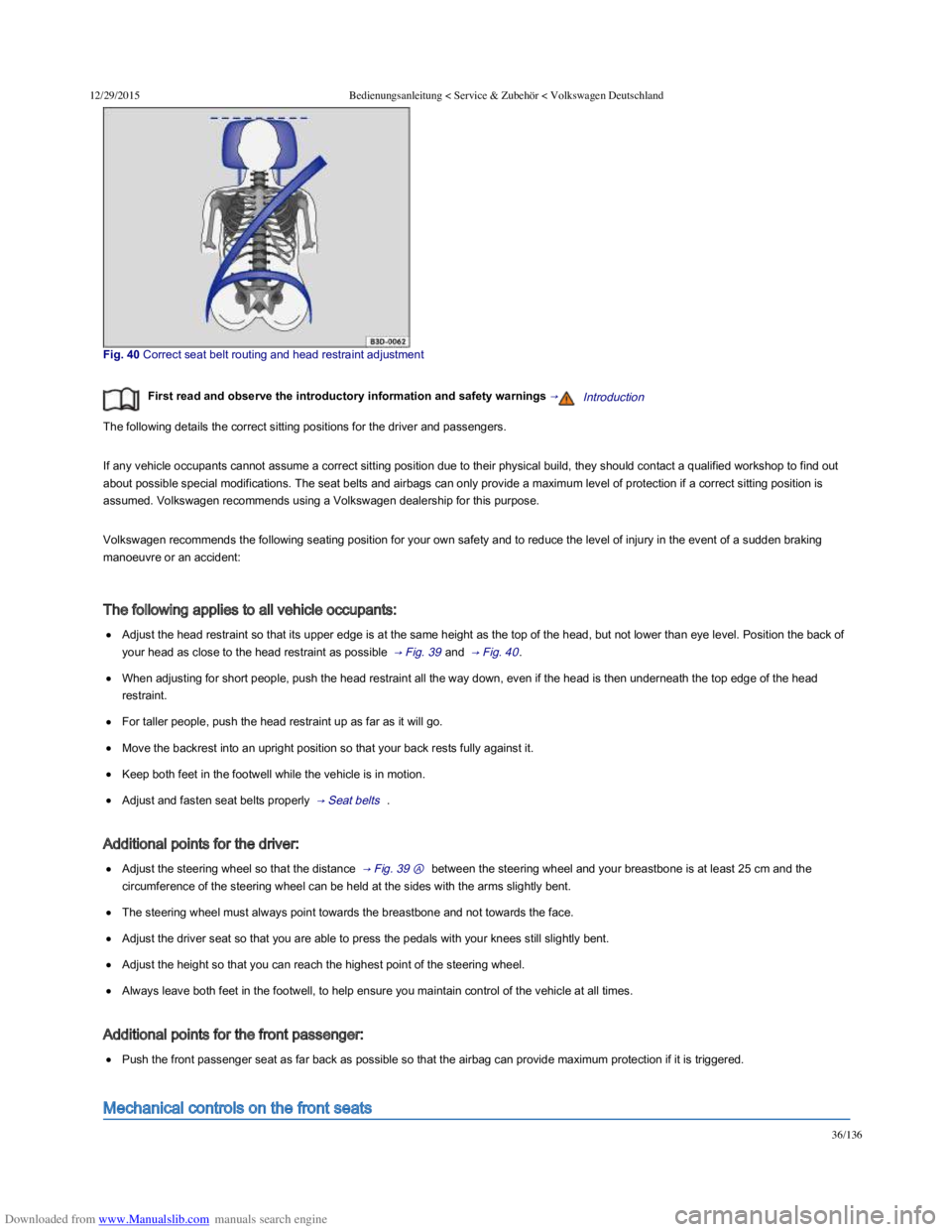
Downloaded from www.Manualslib.com manuals search engine 12/29/2015Bedienungsanleitung < Service & Zubehör < Volkswagen Deutschland
36/136
Fig. 40 Correct seat belt routing and head restraint adjustment
First read and observe the introductory information and safety warnings →Introduction
The following details the correct sitting positions for the driver and passengers.
If any vehicle occupants cannot assume a correct sitting position due to their physical build, they should contact a qualified workshop to find out
about possible special modifications. The seat belts and airbags can only provide a maximum level of protection if a correct sitting position is
assumed. Volkswagen recommends using a Volkswagen dealership for this purpose.
Volkswagen recommends the following seating position for your own safety and to reduce the level of injury in the event of a sudden braking
manoeuvre or an accident:
The following applies to all vehicle occupants:
Adjust the head restraint so that its upper edge is at the same height as the top of the head, but not lower than eye level. Position the back of
your head as close to the head restraint as possible → Fig. 39 and → Fig. 40 .
When adjusting for short people, push the head restraint all the way down, even if the head is then underneath the top edge of the head
restraint.
For taller people, push the head restraint up as far as it will go.
Move the backrest into an upright position so that your back rests fully against it.
Keep both feet in the footwell while the vehicle is in motion.
Adjust and fasten seat belts properly → Seat belts .
Additional points for the driver:
Adjust the steering wheel so that the distance → Fig. 39 Ⓐ between the steering wheel and your breastbone is at least 25 cm and the
circumference of the steering wheel can be held at the sides with the arms slightly bent.
The steering wheel must always point towards the breastbone and not towards the face.
Adjust the driver seat so that you are able to press the pedals with your knees still slightly bent.
Adjust the height so that you can reach the highest point of the steering wheel.
Always leave both feet in the footwell, to help ensure you maintain control of the vehicle at all times.
Additional points for the front passenger:
Push the front passenger seat as far back as possible so that the airbag can provide maximum protection if it is triggered.
Mechanical controls on the front seats
Page 76 of 100

Downloaded from www.Manualslib.com manuals search engine 12/29/2015Bedienungsanleitung < Service & Zubehör < Volkswagen Deutschland
41/136
Fig. 45 Adjusting the steering wheel position mechanically
First read and observe the introductory information and safety warnings →Introduction
Adjust the steering wheel position before setting off and only when the vehicle is stationary.
Push down the lever → Fig. 45 ① .
Adjust the steering wheel so that you can hold it on the outside of the ring (at the 9 o'clock and 3 o'clock positions) with both hands and
slightly bent arms.
Push the lever up firmly until it lines up with the steering column → .
Centre armrest
Incorrect use of the steering column position adjustment and incorrect adjustment of the steering wheel can cause serious or fatal injuries.
After adjusting the steering column, always move lever → Fig. 45 ① up so that it engages securely. This prevents the steering column from
moving spontaneously while the vehicle is in motion.
Never adjust the steering wheel when the vehicle is in motion. If you determine that a readjustment is necessary, stop the vehicle safely and
adjust the steering wheel to the correct position.
The steering wheel must always point towards the chest and not towards the face. This ensures that the driver front airbag provides
maximum protection in the event of an accident.
While driving, always keep both hands on the outside of the steering wheel, at the 9 o'clock and 3 o'clock positions. This reduces the risk of
injury if the driver front airbag is triggered.
Never hold the steering wheel at the 12 o'clock position, or in any other manner, e.g. on the hub of the steering wheel. If the driver airbag is
triggered, you could receive severe injuries to the arms, hands and head.
WARNING
Page 77 of 100
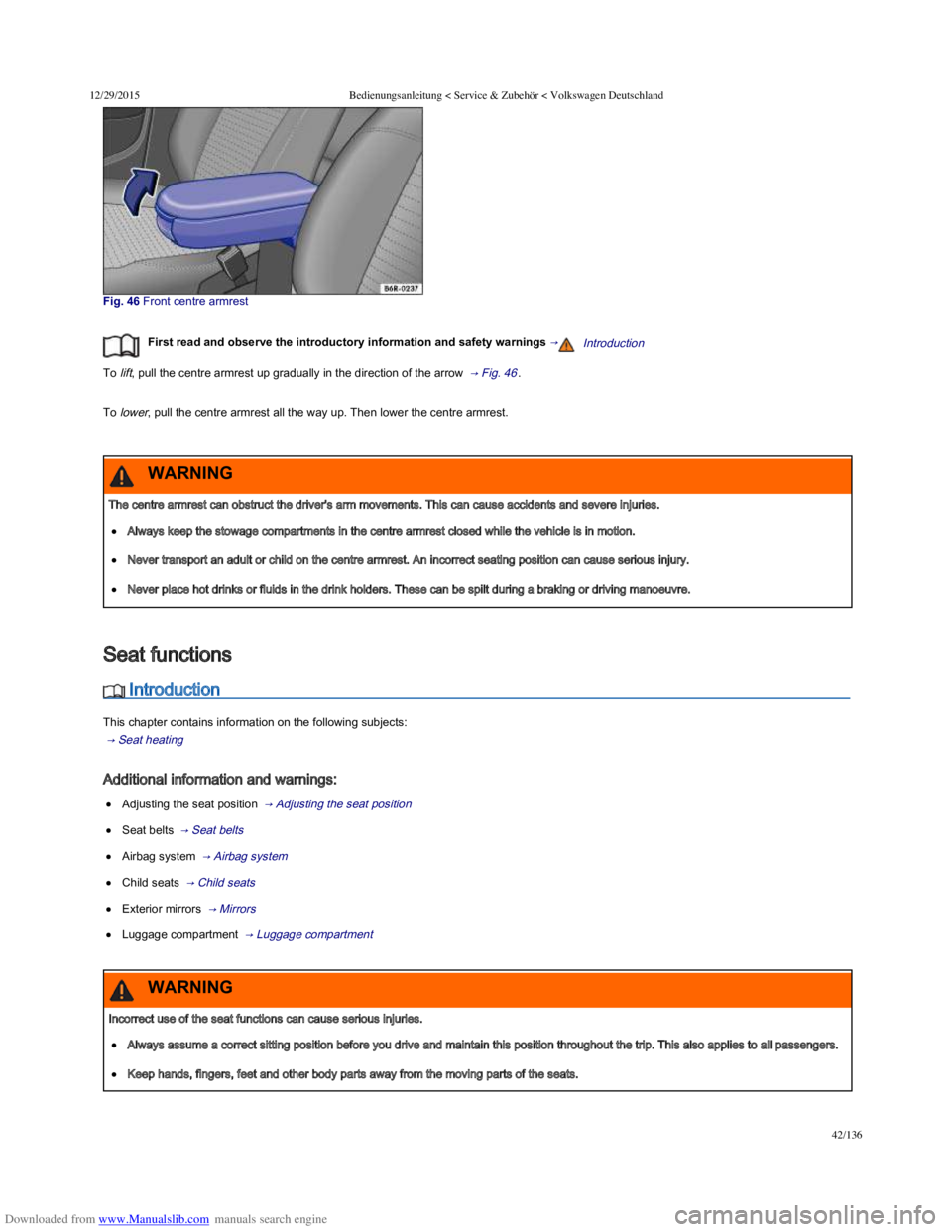
Downloaded from www.Manualslib.com manuals search engine 12/29/2015Bedienungsanleitung < Service & Zubehör < Volkswagen Deutschland
42/136
Fig. 46 Front centre armrest
First read and observe the introductory information and safety warnings →Introduction
To lift, pull the centre armrest up gradually in the direction of the arrow → Fig. 46 .
To lower, pull the centre armrest all the way up. Then lower the centre armrest.
Introduction
This chapter contains information on the following subjects:
→ Seat heating
Additional information and warnings:
Adjusting the seat position → Adjusting the seat position
Seat belts → Seat belts
Airbag system → Airbag system
Child seats → Child seats
Exterior mirrors → Mirrors
Luggage compartment → Luggage compartment
Seat heating
The centre armrest can obstruct the driver's arm movements. This can cause accidents and severe injuries.
Always keep the stowage compartments in the centre armrest closed while the vehicle is in motion.
Never transport an adult or child on the centre armrest. An incorrect seating position can cause serious injury.
Never place hot drinks or fluids in the drink holders. These can be spilt during a braking or driving manoeuvre.
WARNING
Seat functions
Incorrect use of the seat functions can cause serious injuries.
Always assume a correct sitting position before you drive and maintain this position throughout the trip. This also applies to all passengers.
Keep hands, fingers, feet and other body parts away from the moving parts of the seats.
WARNING
Page 79 of 100
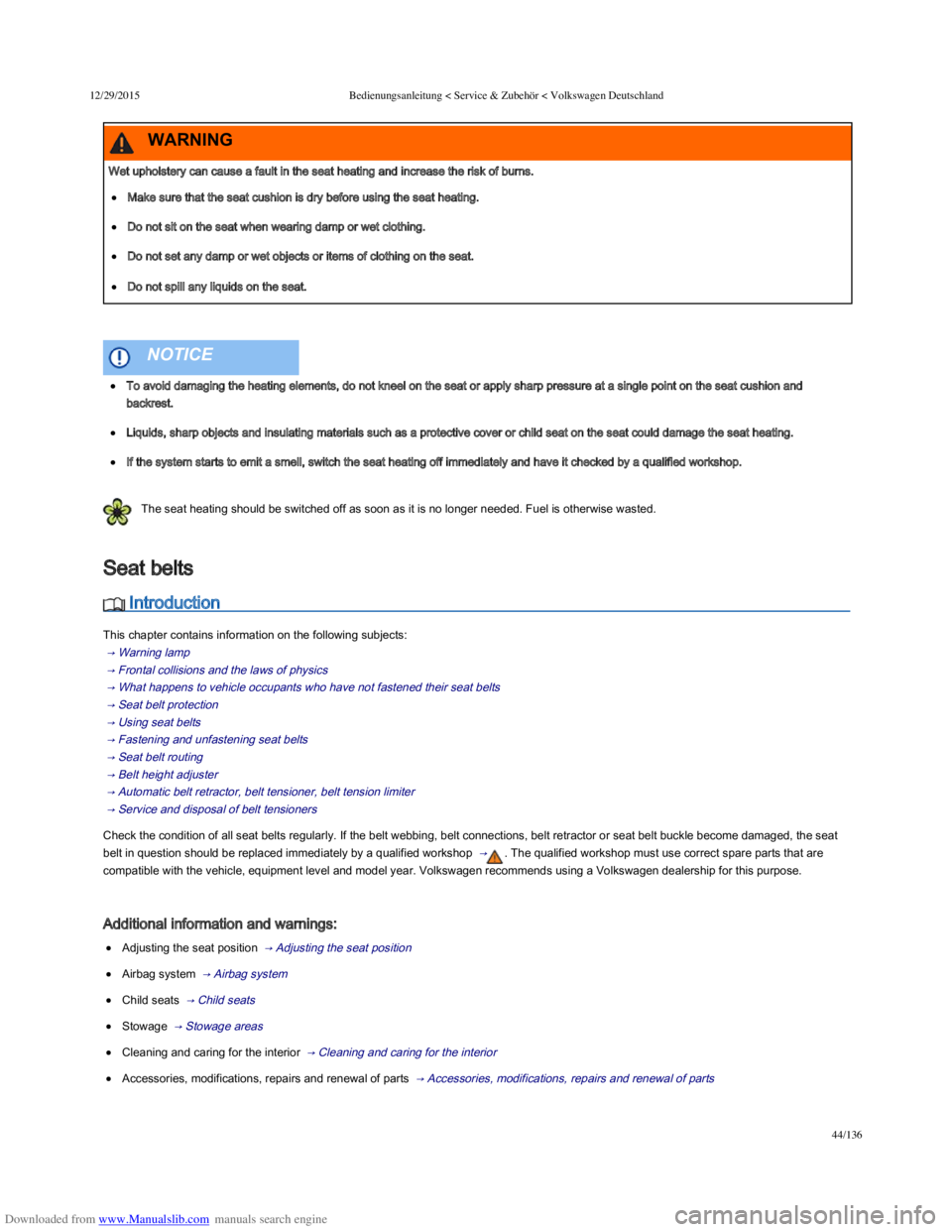
Downloaded from www.Manualslib.com manuals search engine 12/29/2015Bedienungsanleitung < Service & Zubehör < Volkswagen Deutschland
44/136
The seat heating should be switched off as soon as it is no longer needed. Fuel is otherwise wasted.
Introduction
This chapter contains information on the following subjects:
→ Warning lamp
→ Frontal collisions and the laws of physics
→ What happens to vehicle occupants who have not fastened their seat belts
→ Seat belt protection
→ Using seat belts
→ Fastening and unfastening seat belts
→ Seat belt routing
→ Belt height adjuster
→ Automatic belt retractor, belt tensioner, belt tension limiter
→ Service and disposal of belt tensioners
Check the condition of all seat belts regularly. If the belt webbing, belt connections, belt retractor or seat belt buckle become damaged, the seat
belt in question should be replaced immediately by a qualified workshop → . The qualified workshop must use correct spare parts that are
compatible with the vehicle, equipment level and model year. Volkswagen recommends using a Volkswagen dealership for this purpose.
Additional information and warnings:
Adjusting the seat position → Adjusting the seat position
Airbag system → Airbag system
Child seats → Child seats
Stowage → Stowage areas
Cleaning and caring for the interior → Cleaning and caring for the interior
Accessories, modifications, repairs and renewal of parts → Accessories, modifications, repairs and renewal of parts
Wet upholstery can cause a fault in the seat heating and increase the risk of burns.
Make sure that the seat cushion is dry before using the seat heating.
Do not sit on the seat when wearing damp or wet clothing.
Do not set any damp or wet objects or items of clothing on the seat.
Do not spill any liquids on the seat.
WARNING
To avoid damaging the heating elements, do not kneel on the seat or apply sharp pressure at a single point on the seat cushion and
backrest.
Liquids, sharp objects and insulating materials such as a protective cover or child seat on the seat could damage the seat heating.
If the system starts to emit a smell, switch the seat heating off immediately and have it checked by a qualified workshop.
NOTICE
Seat belts
Page 83 of 100
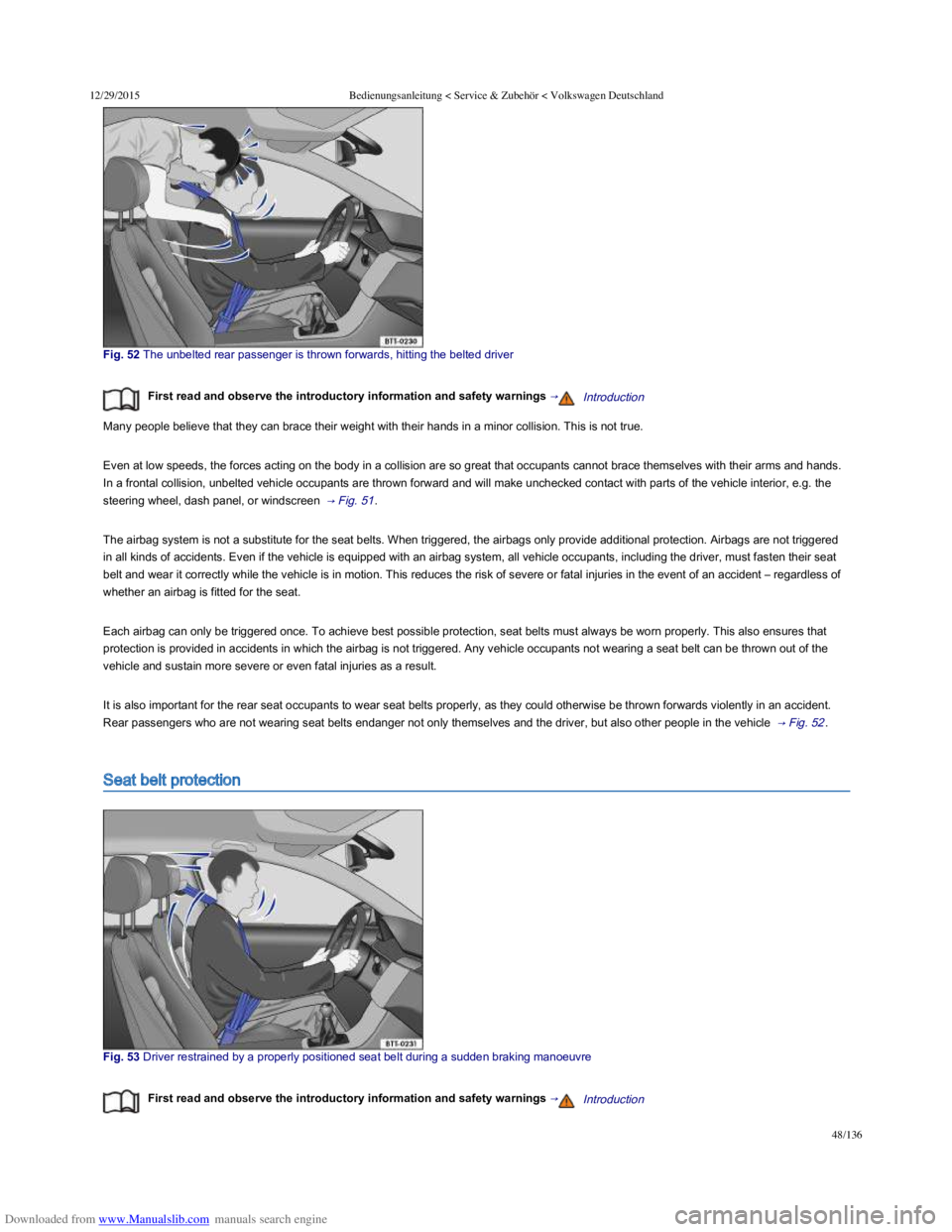
Downloaded from www.Manualslib.com manuals search engine 12/29/2015Bedienungsanleitung < Service & Zubehör < Volkswagen Deutschland
48/136
Fig. 52 The unbelted rear passenger is thrown forwards, hitting the belted driver
First read and observe the introductory information and safety warnings →Introduction
Many people believe that they can brace their weight with their hands in a minor collision. This is not true.
Even at low speeds, the forces acting on the body in a collision are so great that occupants cannot brace themselves with their arms and hands.
In a frontal collision, unbelted vehicle occupants are thrown forward and will make unchecked contact with parts of the vehicle interior, e.g. the
steering wheel, dash panel, or windscreen → Fig. 51 .
The airbag system is not a substitute for the seat belts. When triggered, the airbags only provide additional protection. Airbags are not triggered
in all kinds of accidents. Even if the vehicle is equipped with an airbag system, all vehicle occupants, including the driver, must fasten their seat
belt and wear it correctly while the vehicle is in motion. This reduces the risk of severe or fatal injuries in the event of an accident – regardless of
whether an airbag is fitted for the seat.
Each airbag can only be triggered once. To achieve best possible protection, seat belts must always be worn properly. This also ensures that
protection is provided in accidents in which the airbag is not triggered. Any vehicle occupants not wearing a seat belt can be thrown out of the
vehicle and sustain more severe or even fatal injuries as a result.
It is also important for the rear seat occupants to wear seat belts properly, as they could otherwise be thrown forwards violently in an accident.
Rear passengers who are not wearing seat belts endanger not only themselves and the driver, but also other people in the vehicle → Fig. 52 .
Seat belt protection
Fig. 53 Driver restrained by a properly positioned seat belt during a sudden braking manoeuvre
First read and observe the introductory information and safety warnings →Introduction
Page 84 of 100
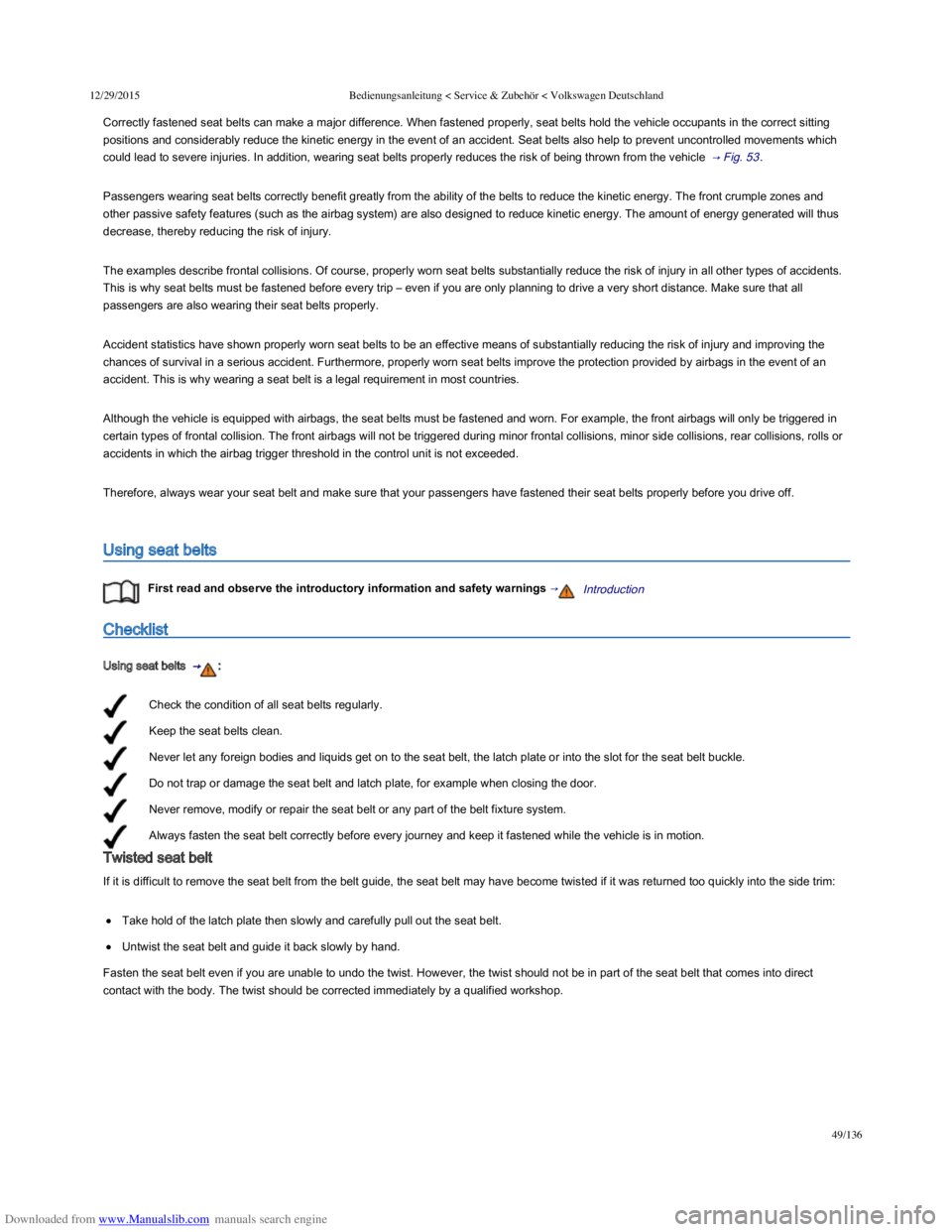
Downloaded from www.Manualslib.com manuals search engine 12/29/2015Bedienungsanleitung < Service & Zubehör < Volkswagen Deutschland
49/136
Check the condition of all seat belts regularly.
Keep the seat belts clean.
Never let any foreign bodies and liquids get on to the seat belt, the latch plate or into the slot for the seat belt buckle.
Do not trap or damage the seat belt and latch plate, for example when closing the door.
Never remove, modify or repair the seat belt or any part of the belt fixture system.
Always fasten the seat belt correctly before every journey and keep it fastened while the vehicle is in motion.
Correctly fastened seat belts can make a major difference. When fastened properly, seat belts hold the vehicle occupants in the correct sitting
positions and considerably reduce the kinetic energy in the event of an accident. Seat belts also help to prevent uncontrolled movements which
could lead to severe injuries. In addition, wearing seat belts properly reduces the risk of being thrown from the vehicle → Fig. 53 .
Passengers wearing seat belts correctly benefit greatly from the ability of the belts to reduce the kinetic energy. The front crumple zones and
other passive safety features (such as the airbag system) are also designed to reduce kinetic energy. The amount of energy generated will thus
decrease, thereby reducing the risk of injury.
The examples describe frontal collisions. Of course, properly worn seat belts substantially reduce the risk of injury in all other types of accidents.
This is why seat belts must be fastened before every trip – even if you are only planning to drive a very short distance. Make sure that all
passengers are also wearing their seat belts properly.
Accident statistics have shown properly worn seat belts to be an effective means of substantially reducing the risk of injury and improving the
chances of survival in a serious accident. Furthermore, properly worn seat belts improve the protection provided by airbags in the event of an
accident. This is why wearing a seat belt is a legal requirement in most countries.
Although the vehicle is equipped with airbags, the seat belts must be fastened and worn. For example, the front airbags will only be triggered in
certain types of frontal collision. The front airbags will not be triggered during minor frontal collisions, minor side collisions, rear collisions, rolls or
accidents in which the airbag trigger threshold in the control unit is not exceeded.
Therefore, always wear your seat belt and make sure that your passengers have fastened their seat belts properly before you drive off.
Using seat belts
First read and observe the introductory information and safety warnings →Introduction
Checklist
Using seat belts → :
Twisted seat belt
If it is difficult to remove the seat belt from the belt guide, the seat belt may have become twisted if it was returned too quickly into the side trim:
Take hold of the latch plate then slowly and carefully pull out the seat belt.
Untwist the seat belt and guide it back slowly by hand.
Fasten the seat belt even if you are unable to undo the twist. However, the twist should not be in part of the seat belt that comes into direct
contact with the body. The twist should be corrected immediately by a qualified workshop.
Page 87 of 100
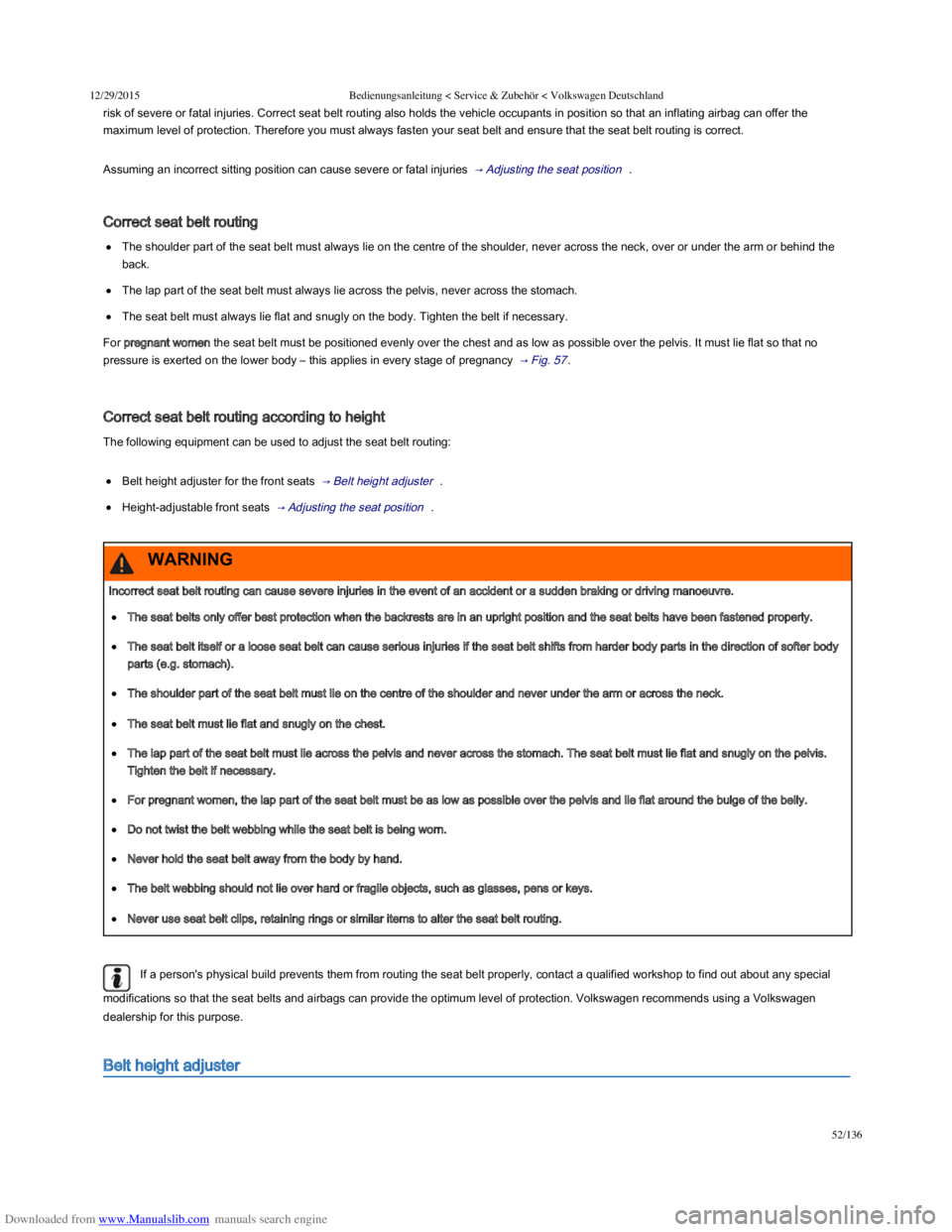
Downloaded from www.Manualslib.com manuals search engine 12/29/2015Bedienungsanleitung < Service & Zubehör < Volkswagen Deutschland
52/136
risk of severe or fatal injuries. Correct seat belt routing also holds the vehicle occupants in position so that an inflating airbag can offer the
maximum level of protection. Therefore you must always fasten your seat belt and ensure that the seat belt routing is correct.
Assuming an incorrect sitting position can cause severe or fatal injuries → Adjusting the seat position .
Correct seat belt routing
The shoulder part of the seat belt must always lie on the centre of the shoulder, never across the neck, over or under the arm or behind the
back.
The lap part of the seat belt must always lie across the pelvis, never across the stomach.
The seat belt must always lie flat and snugly on the body. Tighten the belt if necessary.
For pregnant women the seat belt must be positioned evenly over the chest and as low as possible over the pelvis. It must lie flat so that no
pressure is exerted on the lower body – this applies in every stage of pregnancy → Fig. 57 .
Correct seat belt routing according to height
The following equipment can be used to adjust the seat belt routing:
Belt height adjuster for the front seats → Belt height adjuster .
Height-adjustable front seats → Adjusting the seat position .
If a person's physical build prevents them from routing the seat belt properly, contact a qualified workshop to find out about any special
modifications so that the seat belts and airbags can provide the optimum level of protection. Volkswagen recommends using a Volkswagen
dealership for this purpose.
Belt height adjuster
Incorrect seat belt routing can cause severe injuries in the event of an accident or a sudden braking or driving manoeuvre.
The seat belts only offer best protection when the backrests are in an upright position and the seat belts have been fastened properly.
The seat belt itself or a loose seat belt can cause serious injuries if the seat belt shifts from harder body parts in the direction of softer body
parts (e.g. stomach).
The shoulder part of the seat belt must lie on the centre of the shoulder and never under the arm or across the neck.
The seat belt must lie flat and snugly on the chest.
The lap part of the seat belt must lie across the pelvis and never across the stomach. The seat belt must lie flat and snugly on the pelvis.
Tighten the belt if necessary.
For pregnant women, the lap part of the seat belt must be as low as possible over the pelvis and lie flat around the bulge of the belly.
Do not twist the belt webbing while the seat belt is being worn.
Never hold the seat belt away from the body by hand.
The belt webbing should not lie over hard or fragile objects, such as glasses, pens or keys.
Never use seat belt clips, retaining rings or similar items to alter the seat belt routing.
WARNING